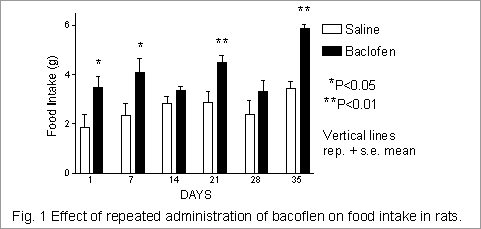Effects of repeated administration of the GABAB receptor agonist baclofen on food intake and body mass in rats
It has been previously reported that acute central or systemic administration of the GABAB receptor agonist baclofen increases food intake in rats by a GABAB receptor mediated mechanism (Ebenezer, 1990, Ebenezer and Pringle, 1992). In addition, it has been shown that chronic administration of baclofen (1 mg kg-1 i.p., twice daily) does not result in the development of tolerance to its hyperphagic effects (Patel et al., 2002a). The present study was undertaken to investigate the effects of repeated administration of baclofen (2 mg kg-1, i.p. once daily) on food intake and body mass in rats. Male Wistar rats (n=16; b. wt: 200 – 300g) were divided into two equal groups. The rats were weighed each day and injected i.p. with either physiological saline solution (Control Group) or baclofen (2 mg kg-1; Test Group) daily for 35 days. All injections were given during the light cycle at 14.00 h. On days 1, 7, 14, 21, 28 and 35, the rats were put individually into separate experimental boxes immediately after their injections and presented with food and water. Food intake was measured, as described previously (Ebenezer, 1990). Fig. 1 shows the effects of baclofen on cumulative food intake measured 30 min after administration. Statistical analysis of the data (two way ANOVA with repeated measures on days) indicated a significant main effects of treatment (F(1,14) = 15.1973, P<0.01). Newman Kuel post-hoc tests revealed that baclofen significantly increased food intake on each measurement day, except days 14 and 28. The reason for this fluctuation is not known. The observation that there was no significant interaction between treatment x days (F(5,70) = 1.9973, n.s.) indicate that tolerance does not develop to the hyperphagic effect of baclofen with repeated administration. Over the 35 day treatment period, the body mass of the rats increased by 49 ± 3 % and 46 ± 2% respectively in the Control and Test Groups. Repeated exposure to baclofen had no significant effects on body mass on any day during the experiment. The present data confirm and extend previous findings (Patel et al., 2002a) and show that tolerance does not develop to the hyperphagic effects of baclofen with repeated administration over a 35 day period. Furthermore, repeated treatment with baclofen has no effect on body mass. These results suggest that although baclofen causes an increase in feeding, this is not reflected in weight gain. One possibility is that although baclofen produces an acute hyperphagia following administration, the animals accurately regulate their food intake over a 24h period to prevent increases in body weight (Ebenezer et al., 1990; Patel et al., 2002b). Another possibility is that baclofen may increase metabolic rate.
Ebenezer, I.S. (1990) NeuroReport 1, 73-76. |


